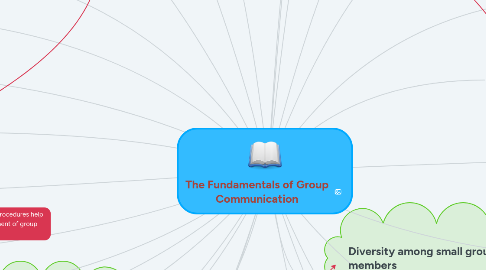The Fundamentals of Group Communication
by kaiden worthington

1. Inequity: Conflict centers on a group members perceived imbalance between his contribution to the group and the contribute made by the group members
2. Rule 1: No evaluation should occur during the session, no matter how outlandish or nonsensical the ideas may seem.
3. Rule 3: Members should be encouraged to be creatively wild and crazy.
4. Rule 2: Members should generate as many ideas as possible without extended pauses.
5. Rule 4: Piggybacking or hitchhiking on each others ideas is important.
6. A functional approach to small groups focuses on the communicative behaviors used by group members during group meetings.
7. There are formal roles and informal roles. Informal roles emerges through group member interaction and formal roles describe specific role positions assigned to one group member through appointment or election as part of the groups structure.
8. White, red, black, yellow, green, and blue. These hats describe different approaches to the decision that helps a group come to a conclusion about what to do.
9. Six thinking hats to help us simplify thinking by having a group focus soley on one aspect of the decision.
10. From constructive conflict you usually gain something and from destructive conflict it usually affects you negatively.
11. Conflict in the Small Group
11.1. Conflict: The process that occurs when group members, due to their interdependence, their real and perceived differences, and their emotions, engage in an expressed struggle that impedes task accomplishment
11.1.1. Conflict is either always constructive or destructive
11.1.2. Affective:
11.1.3. Behavioral:
11.1.4. Cognitive:
11.2. Substantive: Conflict centers on group members critical evaluation of ideas.
11.3. Affective: Conflict centers on individual group members communication and personality traits.
11.4. Procedural: Conflict centers on the procedures group members use to critically evaluate ideas or confront member behavior
12. Small Group Decision making procedures
12.1. Brainstorming Rules:
13. Development of Small Group Roles
14. Roles are developed in two primary ways. The first way is to engage in information seeking. The second way is to solicit feedback.
15. A role is a repeatable pattern of communicative behaviors that group members come to expect from each other
16. Conflict is a necessary part of group communication. People tend to try and avoid it, but it is important to face and understand.
17. Keep to the facts. Very often conflicts escalate to places that end up being all about hurt feelings and egos, not the actual issues. Recognize your feelings, even voicing them, but remember that the other person has been emotionally affected as well. Keep a cool head, or take a break until you are able to have one.
18. There are different types of small groups. There are primary groups which consists of members engaged in an intimate relationship. There are social groups which consists of members whose membership is composed of individuals in intimate relationships a social group is members who also engage in common activities that bind them. There are also self-help groups who's memberships comprise individuals who share a common problem or life situation.
19. Group size is generally 3 members up to 15 members.
20. Primary features of small group communication are group size and interdependence.
21. Communication Climate: the relative acceptance or rejection a group member feels based on the social and psychological tone of the relationships established among group members.
22. Description versus evaluation: Description and evaluation focus on how group member take ownership of their verbal and nonverbal expressions.
23. Empathy versus neutrality: This focuses on how group members demonstrate concern or indifference toward one another. A group member displaying empathy identifies with the group members and attempts to understand their feelings, needs, and interests.
24. Components of Small Group Communication
25. Cohesion and climate in the small group
26. Diversity among small group members
26.1. Diversity in the work place enables for a much more diverse way of thinking and often helps with creating a much more well rounded approach to learning.
27. Cultural Diversity "comprises the sum of total beliefs, values, attitudes, meanings, perceptions, customs, practices, language, and other articles of social life that are learned, shared, and passed on by a group of people."
28. Power Distance: The inequality that exists between a less powerful person and a more powerful person.
28.1. Uncertainty Distance: The amount of stress that a culture associates with an unknown future.
29. Individualism-collectivism: Whether attention is focused on the group or the individual.
30. Diversity in small groups also helps with new ways of thinking and processing various things. Diversity helps with speeding up the production within an organization.
31. There are four disadvantages to working in a group. Group member task coordination is the first. Social loafing is the second disadvantage. The third disadvantage focuses on the conflict in and of itself. The fourth disadvantage is dealing with group members misbehaviors.


